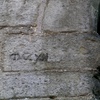Castle of Corfino
The town of Corfino is at an altitude of about 860 metres above sea level, roughly halfway up the southern slope of Mount La Bandita, and has a wonderful view over the Serchio valley.
The castle settlement was structured as a real fortified village, with houses that served as walls, with a longer side to the south and a tip to the north. The only entrance was on the south side of the fortification.
A few elements of the medieval town have survived thanks to recent renovations. Still standing are the gateway to the walled village and several houses.
Still visible inside the entrance gate are the recesses of the old door hinges and holes into which were once driven great wooden bolts to secure the doors during the night or in case of danger. Interestingly, on a shelf to the left appears the date 1212, written with Roman numerals: This would seem to confirm the dating of this structure to the 13th century.
Of a later date is the construction in 1635 of the Sanctuary of the Madonna del Soccorso, or Our Lady of Succour. Inside are preserved several works of art including a stone altar of the 17th century and a painting on wood dated between 1475 and 1490 representing the Madonna and Child, by Pietro Talata.
Historical notes
The first written record of the presence of a village in this locality appears in documentation from Lucca of the year 793, referring to it as a “villa”. The raising of the defences is attributed to the Rolandinghi family and probably at least one part of these was completed in 1212, as confirmed by the inscription cited above. The fortalice had a somewhat troubled life, especially during the 14th century. In 1370, for example, Orlando and Alderigo Antelminelli managed to occupy the small military outpost and with it also other communities of the Garfagnana area. As soon as armies arrived from Lucca, however, the two militants were forced to retreat with their soldiers. In vengeance, they set fire to the conquered fortresses and thus Corfino was particularly heavily damaged. The considerable damage to the village and the castle was reason for which the government of Lucca made special concessions in order to allow the population to recover. Perhaps because of the fact that the defences of the castle were still unusable, the Golden Bull signed in 1376 by Emperor Charles IV of Bohemia defined Corfino as a mere “Commune” and not as a fortress town.
The castle was rebuilt during the Guinigiana era and remained in the hands of Lucca until 1429, the year in which many lands of Garfagnana, fearing occupation by the troops of Niccolo Fortebraccio, preferred to give in peacefully to Niccolò of the House of Este, then Marquis of Ferrara.










